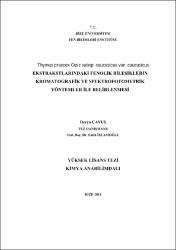Thymus praecox Opiz subsp. caucasicus var. caucasicus ekstrakstlarındaki fenolik bileşiklerin kromatografik ve spektrofotometrik yöntemler ile belirlenmesi
Özet
Bu çalışma kapsamında, yöresel adı Anzer çayı olan Lamiaceae familyasından Thymus praecox Opiz subsp. caucasicus var. caucasicus bitkisinin fenolik bileşikleri spektrofotometrik ve HPLC-UV yöntemleri ile analiz edildi. Başlangıçta bitkiden fenolik bileşiklerin ekstraksiyonlarının optimizasyon çalışması yapıldı. Metanolik ekstraktlar pH=2 ve pH=7'de sulu çözeltiye alındı ve paralel olarak asidik hidroliz işlemi uygulandıktan sonra sıvı-sıvı ekstraksiyonu ve iki farklı katı faz ekstraksiyonu yapıldı. Nihai ekstratlar, spektrofotometrik toplam fenolik madde ve HPLC-UV yöntemleri ile analiz edildi. Bu işlem yalnızca bitkinin çiçek kısmına uygulanıp yaprak ve dal kısmına uygulanmadı. Bulunan sonuçlar karşılaştırılarak asidik hidrolizin ardından sıvı-sıvı ekstraksiyonunun en uygun yöntem olduğu belirlendi. Bitkinin çiçek, yaprak ve dal kısımlarının fenolik bileşikleri de bu şekilde ekstrakte edilerek HPLC-UV ile analiz edildi. Tüm ekstraksiyonların geri kazanım değerleri, örneklere uygulanan işlemler aynı şekilde standart fenolik maddelere de uygulanarak hesaplandı.HPLC-UV kromatogramlarının elüsyon profilleri ve ekstraksiyon işlemine göre değişen davranışlarından elde edilen ipuçları bitkinin başlıca fenolik bileşiminin, kafeik asit gibi sinamik asit türevleri ve kuersetin gibi flavonoid türevlerinden oluştuğunu gösterdi. HPLC-UV analizleri ayrıca bitkinin kafeik asit, rutin, kuersetin ve kamferol içerdiğini de gösterdi. In this study context, spectrophotometric and HPLC-UV analysis of the phenolic compounds of the plant of Thymus praecox Opiz subsp. caucasicus var. caucasicus from Lamiaceae family which is traditionally called Anzer tea was carried out. Optimization of extraction of phenolic compounds from the plant was performed at the beginning. Liquid-liquid extraction at pH=2 and pH=7 in aqueous solutions of methanol extracts and in the aqueous solution after acidic hydrolysis were performed. Two different solid phase extractions were also carried out on methanol extracts. Obtained extracts were analyzed by spectrophotometric and HPLC-UV methods. The extraction optimization was applied only for the flower part of the plant. The extraction method was determined as liquid-liquid extraction after acidic hydrolysis by the comparison of the results of spectrophotometric total phenolic content and HPLC-UV analysis. The phenolic compounds of flower, leaf and stem parts of the plant were extracted by this selected extraction method and analyzed by HPLC-UV as well. The recovery values of all extraction were determined by the extraction of standart phenolic compounds as parallel.The clues obtained by the elusion profiles of the HPLC-UV chromatograms and the behavior depending on the extraction method showed that the major plant phenolic contents are the derivatives of cinnamic acid and the flavonoids mainly caffeic acid and quercetin respectively. According to HPLC-UV analysis, the plant consists of caffeic acid, rutin, quercetin and kaempferol as well.
Bağlantı
https://hdl.handle.net/11436/687Koleksiyonlar
- Fen Bilimleri Enstitüsü [340]


















